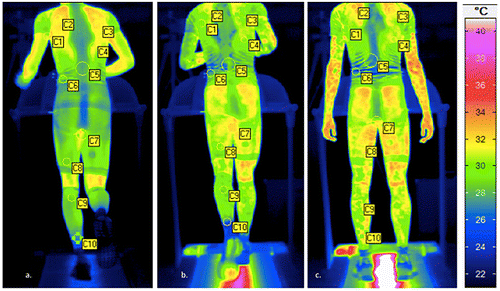1. Introduction
The market for compression clothing has developed considerably to manage the demand of athletes who are looking for optimum conditions to improve their performance and recovery (Doan et al. Citation2003; Bringard et al. Citation2006). Some studies are worked on the compression influences on physiology, biomechanics or thermoregulation. The effects on cardiovascular and thermoregulatory strain remain equivocal. For thermal regulation, many studies point out interests of compression garments in sport (Doan et al. Citation2003). Nielsen and Endrusick (1989) have shown that different knitwear structure influences the cutaneous temperature. Iker et al. (Citation2016) studied the effects of an upper body compression garment on thermoregulatory responses during cycling in a laboratory. No differences are showed in thermoregulatory effects during exercise. Some research showed that by wearing compressive equipment, the muscle compression allows a better muscular support and significantly reduce muscular oscillations (Lussiana et al. Citation2015). The aim of the present study was to determine the effects of a new selective compression garment on thermoregulation and muscular oscillations with the aim of creating a new selective compression shorts.
2. Methods
2.1. Thermoregulation
A crossover control and randomized study was realized on 11 regular sportsmen. Subjects have to run on treadmill with incremented speed between 45 and 15 min of recovery for 2 conditions, CSX short or control short (Jones and Doust, 1996). Thermo-Hygro sensors and Infrared camera are used to collect variations in temperature and humidity during exercise. Sensors were placed on the skin at 4 areas: quadriceps, hamstring, adductors and gluteal. The measurement frequency was 2 data per minute.
2.2. Muscular Oscillations
A crossover control and randomized study was realized on 10 regular sportsmen. Subjects should realize 3 Squat Jump in 2 conditions, CSX short (compression selective on short) or control short. Triaxial accelerometers were used to collect acceleration data. Sensors were placed on 3 positions: quadriceps femoris, hamstring and tensor fasciae latae.
A statistics analysis was realized with Student t-test to compare the effects of CSX short and control short.
3. Results and discussion
3.1. Compression selective and Thermoregulation
The infrared images (Figure ) were taken during the different phases of exercise. One may notice that the skin temperature increase during exercise. Indeed, exercise increases metabolic heat production and invokes thermal regulatory processes. One can observe that the skin temperature distribution presents hyperthermal spots due to the presence of perforator vessels who reach the surface of skin (Lussiana et al. Citation2015).
Figure 1. Infrared cartographies of back view of lower and upper limbs (a: t = 0, b: t = 20, c: t = 45).

Table indicates that variations of temperature have significant reductions for hamstring (p < 0.05) and adductors (p < 0.05). Variations of humidity have significant reductions for quadriceps (p < 0.05), adductors (p < 0.05) and buttocks (p < 0.005).
Table 1. Thermal variation of 4 areas during exercise (*p < 0.05; **p < 0.005).
Results show that compression garment didn’t influence negatively the performance or the temperature (Houghton et al. Citation2009) but subjects prefer it (+2 points) in term of perception (Harnisch et al. Citation2015). CSX shorts have a better evacuation of sweat with 40% on average than control short on exercise.
3.2. Compression selective and muscular oscillations
The CSX short has significant reductions of muscular oscillations than control short for quadriceps (semi-rigid knitwear, p < 0.05) and hamstring (rigid knitwear, p < 0.05). TFL has not a significant reduction because its light knitwear allows reducing compression on tensor fasciae latae to avoid iliotibial band syndrome.
Selective compression conceded a break of the vibrations signal with a rupture of its direction of movement (Abercromby et al. Citation2007). Semi-rigid knitwear allows reducing more muscular oscillations than rigid knitwear unlike the hypothesis. Knitwear structure shows that the pressure is more important for rigid knitwear than semi-rigid. Rigid knitwear does not cover entirely the hamstring.
4. Conclusions
The results show that the CSX shorts have not an effect on skin temperature. These results were consistent with previous researches.
However, one may notice that the CSX shorts have significant reductions of muscular oscillations and humidity on the skin during exercise. The perspectives should find a correlation between muscular oscillations and thermoregulation with selective compression short during exercise. Then compare CSX short to another compression short to the extent of finding the best positions for all the meshes. A new CSX short was designed with the results of this study and the K-Taping conception order to respect biomechanics and prevent injuries.
References
- Abercromby AF, Amonette WE, Layne CS, McFarlin BK, Hinman MR, Paloski WH. 2007. Vibration exposure and biodynamic responses during whole-body vibration training. Med Sci Sports Exerc.
- Arfaoui A, Bertucci W, Letellier T, Polidori G. 2014. Thermoregulation during incremental exercise in masters cycling. J Sci Cycling.
- Bringard A, Denis R, Belluye N, Perrey S. 2006. Effects of compression tights on calf muscle oxygenation and venous pooling during quiet resting in supine and standing positions. J Sports Med Phys Fitness.
- Doan B, Kwon Y-H, Newton R, Shim J, Popper E, Rogers R, Bolt L, Robertson M, Kraemer W. 2003. Evaluation of a Lower-Body Compression Garment. J Sports Sci.
- Harnisch M, Klepser A, Classen E, Beringer J, Schmidt A. 2015. Influence of sports compression textiles on endurance running performance. Extreme Physiol Med.
- Houghton LA, Dawson B, Maloney SK. 2009. Effects of wearing compression garments on thermoregulation during simulated team sport activity in temperate environmental conditions. J Sci Med Sport.
- Iker L, Nicholas T, Roberto AJ. 2016. Heat dissipating upper body compression garment: thermoregulatory, cardiovascular, and perceptual responses. J Sport Health Sci.
- Lussiana T, Terrillon A, Raynaud JL, Tordi N, Mourot L, Ménétrier A. 2015. Effet dose-réponse de la compression élastique sur les vibrations musculaires. Sci Sport.
- Nielsen R, Endrusick TL. 1990. Thermoregulatory responses to intermittent exercise are influenced by knit structure of underwear. Eur J Appl Physiol Occup Physiol.
